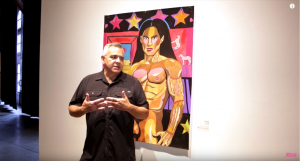The charity event titled “5 Days for the Homeless” is hosted at UBC by the Commerce Community Program at the Sauder School of Business, and its goal is to raise $10,000 for their chosen charity Covenant House Vancouver by staying outside as if homeless on the UBC campus. Some of their ‘conditions’ include, going without shelter, technology, basic amenities, or disposable income for five days, they must also be given any food they consume. This local charity event aims to address a wider problem of homelessness in Vancouver, but fails to address the wider non-local issues that disproportionately displace QTBIPOC folks and youth thus contributing to homelessness overall. On a broader scale in British Columbia Trans and gender non-conforming folks experience high levels of discrimination and harassment when looking for housing or accessing social services (BC Poverty Reduction 2014). Trans and queer folks of colour as well as aboriginal two-spirit persons experience even higher levels of discrimination due to the intersection of being racialized and queer (BC Poverty Reduction 2014). This event inappropriately mimics homelessness in Vancouver and the charity funds could be better utilized to aid LGBTQ2S* and QTBIPOC folks who suffer disproportionately from poverty and homelessness in BC.
The event itself has its front and center poster image of the Sauder student participants with cardboard signs strung around their neck, cups and hands held out, with faces of longing as if pretending or dressing up to be homeless (Sauder 2008). This image is unsettling as it dresses the participants up as homeless, when they are aiming to help the homeless. Mimicking tends to ‘Other’ people because it makes a character out of homelessness.
The circumstance of the ‘homeless’ experience this fundraiser aims to recreate is different to the unknown someone who is displaced and marginalized living on the streets goes through. There are intersections of oppression experienced by QTBIPOC persons who are forced to live on the street besides the physical suffering this event mimics. According to the BC Poverty Reduction fact sheet on LGBTQ issues, “29% of trans people often report being turned away when trying to access shelters, and 22% report being assaulted by residents and staff” (BC LGBQT Poverty Fact Sheet 2014).” Not to mention, one in four queer and trans youth in BC are forced out of their families’ homes due to identity-centered conflicts (BC LGBQT Poverty Fact Sheet 2014). These emotionally draining tribulations contribute to the overall suffering of being in poverty and homeless. Clean warm sleeping bags, curious peers on campus, and welcoming campus security all contribute to the ways this event cannot simulate homelessness in Vancouver. Homeless people cannot guarantee their safety or a welcoming response from the police sleeping on the streets. Under the picture is an article that continues on to describe the intention of the original “5 Days for Homelessness Campaign” as “…created by three University of Alberta business students as a way to support the disadvantaged and help change public perceptions of business students. (Sauder 2008).” This clearly defines their intention to improve public image and perception of business students on a general non-local level by hosting a charity event for the ‘disadvantaged.’
Their choice of charity, Covenant House, is the largest privately funded charity in the Americas for homeless and exploited youth as well as being a Christian affiliated organization (About Covenant House 2017). Despite toting a rainbow flag at the bottom of their webpage, Covenant House’s religious ties and separate gendered services could discourage Trans and Queer folks (Covenant House Vancouver 2017). Critics of Covenant House draw on opinions circulating among LGBTQ2S+ youth that describe the environment to be homophobic (Murphy 2005). Their split gender locations discourage gender non-conforming LGBTQ2S+ persons, and the high client to staff ratio makes it harder to protect the most vulnerable and targeted (Murphy 2005). An example of a homeless charity organization that focuses on the most marginalized among homeless youth and the root of the local problem is Rain City Housing. They offer housing specifically targeted towards Lesbian, Gay, Bisexual, Trans, Queer, Two-Spirit, Plus (LGBTQ2S*) youth and is the first of its kind of program in Canada (Raincity 2017). They address that 25-40% of the homeless population in Vancouver is LGBTQ2S* when only 10% of the total Vancouver population identify as LGBTQ2S* (RainCity 2017). This highlights the way the “5 Days for the Homeless” fundraiser could better affiliate with an organization that accounts for the QTBIPOC homeless youth in Vancouver and British Columbia overall.
The Sauder hosted charity event could more effectively support the local homeless population of Vancouver by affiliating with an organization that addresses and cares for LGBTQ2S* and homeless youth of colour on a grassroots local level. The Sauder Business School should address the intentions of the event and rethink whether they are doing it for a public relations image or for the benefit of the truly most marginalized and disadvantaged in Vancouver. The Covenant House being the biggest charity in the America’s reaffirms the way the money raised could make more of an impact going to a organization that cares for those forgotten about by the big charities. This event as it stands inappropriately mimics homelessness in Vancouver and the charity funds could be better utilized to support the most overlooked local homeless population whom are LGBTQ2S* and persons of colour.
Works Cited
“About Covenant House.” About Covenant House | The Homeless Hub, 2017. homelesshub.ca/toolkit/chapter/about-covenant-house.
Covenant House. “Welcome to Our Homepage.” Covenant House Vancouver, www.covenanthousebc.org/.
Habib, Sadia. “’Othering’ in Education.” The Sociological Imagination, sociologicalimagination.org/archives/18405.
Murphy, Jarrett. “Wounded Pride.” Village Voice, www.villagevoice.com/2005/04/19/wounded-pride/.
Rain City. “LGBTQ2S* Youth Housing.” Raincity Housing, www.raincityhousing.org/what-we-do/lgbtq2s-youth-housing/.
Sauder Business School. “Sauder Students Take Part in 5 Days for the Homeless Campaign.” Suader School of Business, 2008. www.sauder.ubc.ca/News/2008/Sauder_Students_Take_Part_in_5_Days_for_the_Homeless_Campaign.
“University of British Columbia.” 5 Days for the Homeless, 5days.ca/schools/ubc/.

